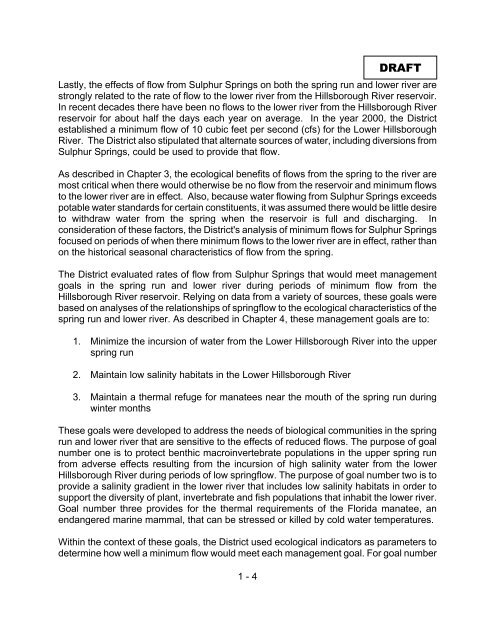The Determination of Minimum Flows for Sulphur Springs, Tampa
The Determination of Minimum Flows for Sulphur Springs, Tampa
The Determination of Minimum Flows for Sulphur Springs, Tampa
Create successful ePaper yourself
Turn your PDF publications into a flip-book with our unique Google optimized e-Paper software.
1 - 4<br />
DRAFT<br />
Lastly, the effects <strong>of</strong> flow from <strong>Sulphur</strong> <strong>Springs</strong> on both the spring run and lower river are<br />
strongly related to the rate <strong>of</strong> flow to the lower river from the Hillsborough River reservoir.<br />
In recent decades there have been no flows to the lower river from the Hillsborough River<br />
reservoir <strong>for</strong> about half the days each year on average. In the year 2000, the District<br />
established a minimum flow <strong>of</strong> 10 cubic feet per second (cfs) <strong>for</strong> the Lower Hillsborough<br />
River. <strong>The</strong> District also stipulated that alternate sources <strong>of</strong> water, including diversions from<br />
<strong>Sulphur</strong> <strong>Springs</strong>, could be used to provide that flow.<br />
As described in Chapter 3, the ecological benefits <strong>of</strong> flows from the spring to the river are<br />
most critical when there would otherwise be no flow from the reservoir and minimum flows<br />
to the lower river are in effect. Also, because water flowing from <strong>Sulphur</strong> <strong>Springs</strong> exceeds<br />
potable water standards <strong>for</strong> certain constituents, it was assumed there would be little desire<br />
to withdraw water from the spring when the reservoir is full and discharging. In<br />
consideration <strong>of</strong> these factors, the District's analysis <strong>of</strong> minimum flows <strong>for</strong> <strong>Sulphur</strong> <strong>Springs</strong><br />
focused on periods <strong>of</strong> when there minimum flows to the lower river are in effect, rather than<br />
on the historical seasonal characteristics <strong>of</strong> flow from the spring.<br />
<strong>The</strong> District evaluated rates <strong>of</strong> flow from <strong>Sulphur</strong> <strong>Springs</strong> that would meet management<br />
goals in the spring run and lower river during periods <strong>of</strong> minimum flow from the<br />
Hillsborough River reservoir. Relying on data from a variety <strong>of</strong> sources, these goals were<br />
based on analyses <strong>of</strong> the relationships <strong>of</strong> springflow to the ecological characteristics <strong>of</strong> the<br />
spring run and lower river. As described in Chapter 4, these management goals are to:<br />
1. Minimize the incursion <strong>of</strong> water from the Lower Hillsborough River into the upper<br />
spring run<br />
2. Maintain low salinity habitats in the Lower Hillsborough River<br />
3. Maintain a thermal refuge <strong>for</strong> manatees near the mouth <strong>of</strong> the spring run during<br />
winter months<br />
<strong>The</strong>se goals were developed to address the needs <strong>of</strong> biological communities in the spring<br />
run and lower river that are sensitive to the effects <strong>of</strong> reduced flows. <strong>The</strong> purpose <strong>of</strong> goal<br />
number one is to protect benthic macroinvertebrate populations in the upper spring run<br />
from adverse effects resulting from the incursion <strong>of</strong> high salinity water from the lower<br />
Hillsborough River during periods <strong>of</strong> low springflow. <strong>The</strong> purpose <strong>of</strong> goal number two is to<br />
provide a salinity gradient in the lower river that includes low salinity habitats in order to<br />
support the diversity <strong>of</strong> plant, invertebrate and fish populations that inhabit the lower river.<br />
Goal number three provides <strong>for</strong> the thermal requirements <strong>of</strong> the Florida manatee, an<br />
endangered marine mammal, that can be stressed or killed by cold water temperatures.<br />
Within the context <strong>of</strong> these goals, the District used ecological indicators as parameters to<br />
determine how well a minimum flow would meet each management goal. For goal number

















